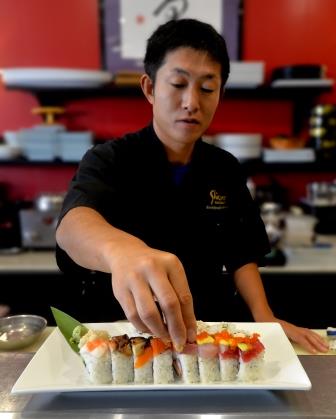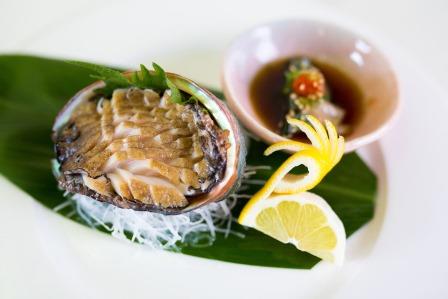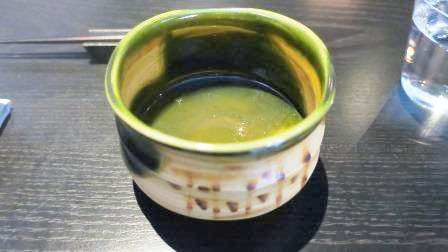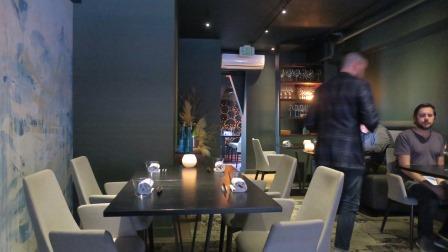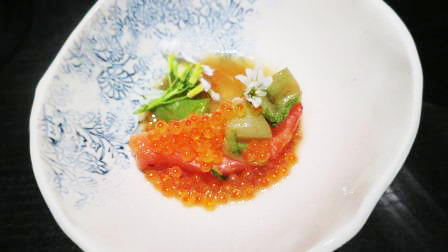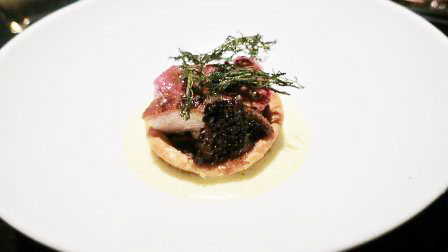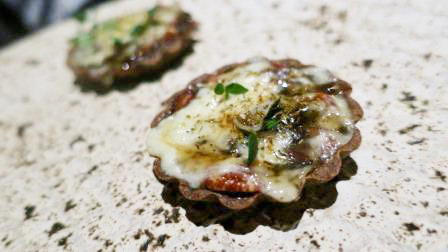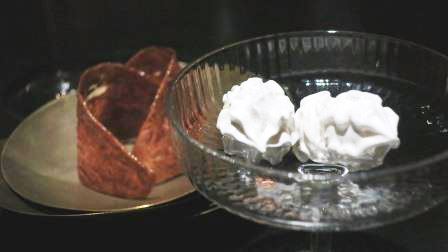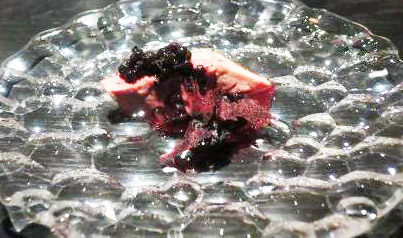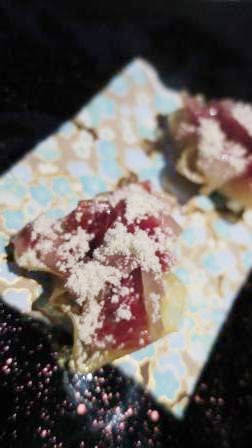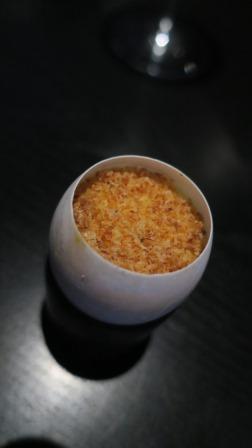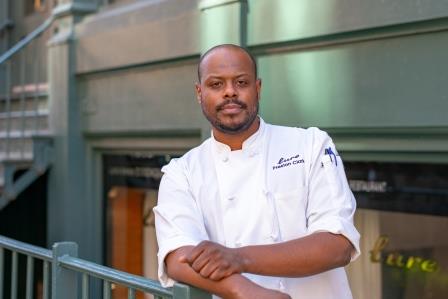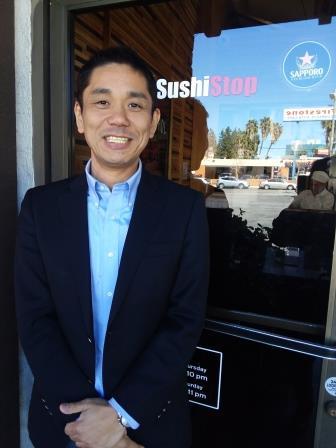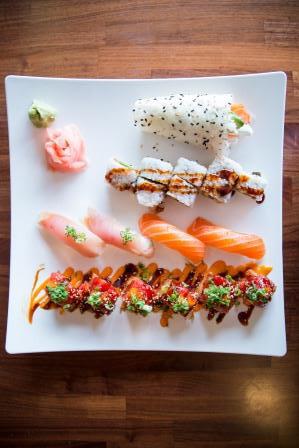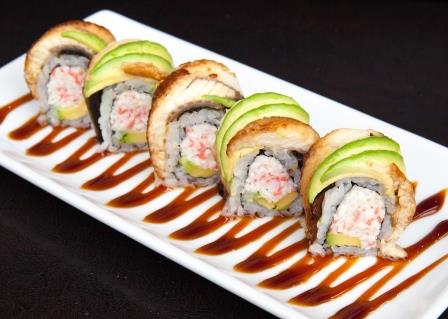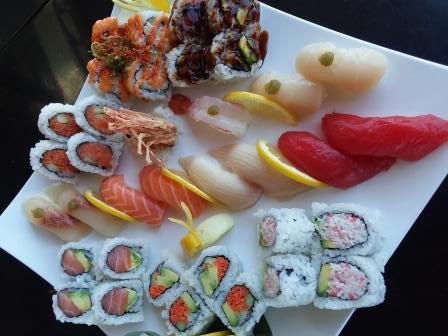Sushi Shioo -A sushi restaurant loved by locals of the Island of Hawaii-
By Keiko Fukuda
Sushi Shiono is a restaurant chain, which has 3 locations on the Island of Hawaii, and each of them is unique. Its Kona location, the first establishment, is a sushi dining place loved by the locals. Its Waikoloa location is a take-out only establishment. It is located in the Queen’s Market Place in the Waikoloa Beach Resort. It has a sushi bar, but is mainly targeted to “Grab and Go” customers. Its third Mauna Lani location, which is about a 5-minute drive north from Waikoloa, is a high-end sushi restaurant, which is very different from the casual Kona location. This place offers omakase, and specially created menu items.
Although these 3 locations are divided by each concept, “a restaurant loved by the locals”, “a take-out only restaurant”, and “a high-end restaurant”, they share the same thing, which is their extreme particularity about the ingredients by using only the fresh seafood caught in the seas near Hawaii, and seafood directly shipped from Japan. Moreover, all of their 4 chefs, who are demonstrating their excellent skills, share experiences of working in Japan.
Now, Sushi Shiono is a popular restaurant chain, which scores high on OpenTable and Yelp; however, I heard that the Kona location was first opened by the owner, who was just a gourmet eater then, as an extension of his hobby.
The owner’s name is Kanichi Shionoya, who runs a generic pharmaceutical company. I heard that Mr. Shionoya, who used to visit the Island of Hawaii to enjoy sport-fishing, thought about opening a sushi restaurant so that he could enjoy the fish he caught there. It became more convincing why he is so particular about the freshness of the ingredients, and bringing chefs from Japan, when I learned that his intention of establishing a restaurant is purely for “his own desire to eat good fish” rather than a business success in mind. This owner also runs various restaurants in Japan besides a sushi restaurant, such as oden, soba, and yakitori restaurants.
I learned from Yuka Murakami of Maruhiro Enterprises, the base operation organization of Sushi Shiono that the Kona location, which is busy with local customers now, used to be filled with Japanese tourists when it first opened in 2003. “Now, our customers consist of 70% locals, 20% tourists, and 10% Japanese who live locally.” Kawakami-san explained the reason for the change of the strategy as follows: “If we aim mainly for tourists as our customers, the number of customers will vary too drastically depending on the season.”
In fact, there are many customers who want to visit the Kona location every week, where sushi chefs rarely change. “Both their dishes and services are the best!”. “You can have genuine Japanese cuisine, not some strange Japanese-like cuisine.” “The taste of sushi made with fresh seafood is superb, and the quality of its vinegared rice is also way better than other restaurants.” “It’s a kid-friendly restaurant, which can be enjoyed by the whole family.” Those are some of the comments the regular customers give.
This is the place famous for serving “genuine Japanese food”. However, they also serve something you can and must taste only in Hawaii. “The Big Island Abalone”, a type of cultivated abalone, is known for its tender texture.
Also, Kona Kampachi is good either as sushi or sashimi. Hawaiian beef is grass-fed in Hawaii, and we serve it as tataki, or sushi.” (by Kawakami)
I had a simple question as to whether Sushi Shiono will ever expand to Oahu or the Mainland. Kawakami-san replied as follows: “I hear that often from the people who visit our Big Island location. I have actually checked out the possibility.
However, due to the fact that our President came to the Big Island to open the restaurant because he loved it here, the chance of us going out of this island in the future is very slim. I would like to keep contributing to the Big Island further into the future by serving the blessings of the island in a delicious way.” However, within the Island of Hawaii, it looks like a piece of new development is on the way. “First, by next summer, we will move the present Kona restaurant to a nearby location. We are planning to make half of the new location a sushi division, and the other half a ramen place. We will keep the lease for the present location, and instead of sushi and ramen, we will reopen it as a different type of Japanese restaurant.” They cannot reveal what type of restaurant it will be yet. I cannot help but keep my eyes on Sushi Shiono, which has settled its roots in the Island of Hawaii to continue to serve Japanese food.
ハワイ島のロコに愛される寿司店
ハワイ島にそれぞれ特色のある3軒の寿司店を出している寿司しおの。1号店であるコナ店は地元客に愛される寿司ダイニング。ワイコロア店はテイクアウトの店。ワイコロア・ビーチリゾートのクイーンズマーケットプレイス内にあり、寿司バーも付設されているが、主に「グラッブ・アンド・ゴー」の顧客がメインのターゲットだ。さらに、ワイコロアから北に車で5分ほど移動した場所にある3店舗目のマウナラニ店は、コナ店のカジュアルな雰囲気とは一線を画す高級志向の寿司店。お任せや創作料理もメニューに並ぶ。
これら3店は、「地元客に愛される店」、「テイクアウト」、「高級志向」とコンセプトを分けてはいるが、共通するのはハワイ近海で獲れた新鮮な魚と日本から直送された魚を扱い、とことん素材にこだわっているという点だ。また、日本での経験を持つ4人の寿司シェフが腕を振るう。
今や繁盛店として、オープンテーブルやYelpでも高得点を獲得している寿司しおのだが、もともとは食通のオーナーが趣味の延長線でコナ店を開けたそうだ。そのオーナーは日本でジェネリック薬品の会社を経営する塩野谷貫一(ルビ:しおのやかんいち)さん。ハワイ島を訪れてはスポーツフィッシングに興じていた塩野谷さんは、現地で釣った魚を美味しく食べたいという気持ちから、島に寿司店を開店することを思い立ったそうだ。ビジネスありきではなく、「自分が食べたい」という純粋な気持ちから店を構えたと聞けば、食材や日本から呼び寄せたシェフに対するこだわりも納得だ。同オーナーは、日本国内でも寿司店、他におでん割烹、蕎麦店、焼き鳥店も経営している。
今は地元客で賑わうコナ店だが、2003年の開店当初、その客層の多くを日本人の観光客が占めていたと教えてくれたのは、寿司しおのの経営母体、マルヒロエンタープライズの川上由香さん。「今は70%がローカルのお客様、20%が観光客、そして10%が現地在住の日本人のお客様といった構成になっています」。地元客向けに戦略を変えた理由を、川上さんは「観光客をターゲットの中心に据えた場合、季節によって来客数のアップダウンが激しくなります」と説明した。
実際、寿司シェフの顔ぶれがほとんど変わることのないコナ店を毎週のように訪れる常連は多い。「料理、サービス共に最高。風変わりな日本食もどきではなく本物の日本食が食べられる」、また「新鮮な魚を使った寿司の美味しさ。酢飯の質も他店のはるか上をいく」「家族で楽しめるキッズフレンドリーな店」といったコメントが常連からは聞かれる。
「本物の日本食」を出すことで定評のあると同店だが、ぜひ食したいハワイならではのマストなネタもある。「ビッグアイランド・アバロンという養殖アワビは柔らかい食感で有名です。また、コナ・カンパチは寿司でも刺身でもおすすめです。ハワイ牛はハワイ産のグラスフェッドビーフ。これをタタキにしたり、またお寿司でもお出ししています」(川上さん)。
オアフ島やメインランドには寿司しおのは進出しないのかという素朴な疑問が浮かぶ。川上さんの返答は次のようなものだった。「ハワイ島の当店にいらっしゃった方にそのようなお話をいただくことは多いです。実際、下見に行ったこともあります。しかし、社長がハワイ島が好きでここに店を出したということもあり、今後、ハワイ島の外に出る可能性は非常に低いと思います。今後もハワイ島の恵みを美味しく提供することで、さらにハワイ島に貢献していきたいと考えています」。ただし、ハワイ島内では新たな展開が生まれそうだ。「まず、夏頃には、今のコナ店をすぐ近くの場所に移転させます。その店舗の半分を寿司店に、残りの半分をラーメン屋さんにする計画です。今の店のリースはそのまま継続し、寿司やラーメンではなく、別の業態の日本食店を新たにオープンさせます」。それが何の店になるかはまだ秘密だそうだ。ハワイ島に根を張って、日本食を提供し続ける寿司しおのから目が離せそうにない。
Sushi Shiono (Kona)
75-5799 ALii Dr. Kailua-Kona, HI 96740
(808)326-1696
http://www.sushishiono.com
Mon.-Thu.11:30am-2:00pm, 5:30pm-9:00pm
Fri. 11:30am-2:00pm, 5:30pm-10:00pm
Sat. 5:30pm- 10:00pm
Sun. 5;00pm-9:00pm
Sushi Shiono is a restaurant chain, which has 3 locations on the Island of Hawaii, and each of them is unique. Its Kona location, the first establishment, is a sushi dining place loved by the locals. Its Waikoloa location is a take-out only establishment. It is located in the Queen’s Market Place in the Waikoloa Beach Resort. It has a sushi bar, but is mainly targeted to “Grab and Go” customers. Its third Mauna Lani location, which is about a 5-minute drive north from Waikoloa, is a high-end sushi restaurant, which is very different from the casual Kona location. This place offers omakase, and specially created menu items.
Although these 3 locations are divided by each concept, “a restaurant loved by the locals”, “a take-out only restaurant”, and “a high-end restaurant”, they share the same thing, which is their extreme particularity about the ingredients by using only the fresh seafood caught in the seas near Hawaii, and seafood directly shipped from Japan. Moreover, all of their 4 chefs, who are demonstrating their excellent skills, share experiences of working in Japan.
Now, Sushi Shiono is a popular restaurant chain, which scores high on OpenTable and Yelp; however, I heard that the Kona location was first opened by the owner, who was just a gourmet eater then, as an extension of his hobby.
The owner’s name is Kanichi Shionoya, who runs a generic pharmaceutical company. I heard that Mr. Shionoya, who used to visit the Island of Hawaii to enjoy sport-fishing, thought about opening a sushi restaurant so that he could enjoy the fish he caught there. It became more convincing why he is so particular about the freshness of the ingredients, and bringing chefs from Japan, when I learned that his intention of establishing a restaurant is purely for “his own desire to eat good fish” rather than a business success in mind. This owner also runs various restaurants in Japan besides a sushi restaurant, such as oden, soba, and yakitori restaurants.
I learned from Yuka Murakami of Maruhiro Enterprises, the base operation organization of Sushi Shiono that the Kona location, which is busy with local customers now, used to be filled with Japanese tourists when it first opened in 2003. “Now, our customers consist of 70% locals, 20% tourists, and 10% Japanese who live locally.” Kawakami-san explained the reason for the change of the strategy as follows: “If we aim mainly for tourists as our customers, the number of customers will vary too drastically depending on the season.”
In fact, there are many customers who want to visit the Kona location every week, where sushi chefs rarely change. “Both their dishes and services are the best!”. “You can have genuine Japanese cuisine, not some strange Japanese-like cuisine.” “The taste of sushi made with fresh seafood is superb, and the quality of its vinegared rice is also way better than other restaurants.” “It’s a kid-friendly restaurant, which can be enjoyed by the whole family.” Those are some of the comments the regular customers give.
This is the place famous for serving “genuine Japanese food”. However, they also serve something you can and must taste only in Hawaii. “The Big Island Abalone”, a type of cultivated abalone, is known for its tender texture.
Also, Kona Kampachi is good either as sushi or sashimi. Hawaiian beef is grass-fed in Hawaii, and we serve it as tataki, or sushi.” (by Kawakami)
I had a simple question as to whether Sushi Shiono will ever expand to Oahu or the Mainland. Kawakami-san replied as follows: “I hear that often from the people who visit our Big Island location. I have actually checked out the possibility.
However, due to the fact that our President came to the Big Island to open the restaurant because he loved it here, the chance of us going out of this island in the future is very slim. I would like to keep contributing to the Big Island further into the future by serving the blessings of the island in a delicious way.” However, within the Island of Hawaii, it looks like a piece of new development is on the way. “First, by next summer, we will move the present Kona restaurant to a nearby location. We are planning to make half of the new location a sushi division, and the other half a ramen place. We will keep the lease for the present location, and instead of sushi and ramen, we will reopen it as a different type of Japanese restaurant.” They cannot reveal what type of restaurant it will be yet. I cannot help but keep my eyes on Sushi Shiono, which has settled its roots in the Island of Hawaii to continue to serve Japanese food.
ハワイ島のロコに愛される寿司店
ハワイ島にそれぞれ特色のある3軒の寿司店を出している寿司しおの。1号店であるコナ店は地元客に愛される寿司ダイニング。ワイコロア店はテイクアウトの店。ワイコロア・ビーチリゾートのクイーンズマーケットプレイス内にあり、寿司バーも付設されているが、主に「グラッブ・アンド・ゴー」の顧客がメインのターゲットだ。さらに、ワイコロアから北に車で5分ほど移動した場所にある3店舗目のマウナラニ店は、コナ店のカジュアルな雰囲気とは一線を画す高級志向の寿司店。お任せや創作料理もメニューに並ぶ。
これら3店は、「地元客に愛される店」、「テイクアウト」、「高級志向」とコンセプトを分けてはいるが、共通するのはハワイ近海で獲れた新鮮な魚と日本から直送された魚を扱い、とことん素材にこだわっているという点だ。また、日本での経験を持つ4人の寿司シェフが腕を振るう。
今や繁盛店として、オープンテーブルやYelpでも高得点を獲得している寿司しおのだが、もともとは食通のオーナーが趣味の延長線でコナ店を開けたそうだ。そのオーナーは日本でジェネリック薬品の会社を経営する塩野谷貫一(ルビ:しおのやかんいち)さん。ハワイ島を訪れてはスポーツフィッシングに興じていた塩野谷さんは、現地で釣った魚を美味しく食べたいという気持ちから、島に寿司店を開店することを思い立ったそうだ。ビジネスありきではなく、「自分が食べたい」という純粋な気持ちから店を構えたと聞けば、食材や日本から呼び寄せたシェフに対するこだわりも納得だ。同オーナーは、日本国内でも寿司店、他におでん割烹、蕎麦店、焼き鳥店も経営している。
今は地元客で賑わうコナ店だが、2003年の開店当初、その客層の多くを日本人の観光客が占めていたと教えてくれたのは、寿司しおのの経営母体、マルヒロエンタープライズの川上由香さん。「今は70%がローカルのお客様、20%が観光客、そして10%が現地在住の日本人のお客様といった構成になっています」。地元客向けに戦略を変えた理由を、川上さんは「観光客をターゲットの中心に据えた場合、季節によって来客数のアップダウンが激しくなります」と説明した。
実際、寿司シェフの顔ぶれがほとんど変わることのないコナ店を毎週のように訪れる常連は多い。「料理、サービス共に最高。風変わりな日本食もどきではなく本物の日本食が食べられる」、また「新鮮な魚を使った寿司の美味しさ。酢飯の質も他店のはるか上をいく」「家族で楽しめるキッズフレンドリーな店」といったコメントが常連からは聞かれる。
「本物の日本食」を出すことで定評のあると同店だが、ぜひ食したいハワイならではのマストなネタもある。「ビッグアイランド・アバロンという養殖アワビは柔らかい食感で有名です。また、コナ・カンパチは寿司でも刺身でもおすすめです。ハワイ牛はハワイ産のグラスフェッドビーフ。これをタタキにしたり、またお寿司でもお出ししています」(川上さん)。
オアフ島やメインランドには寿司しおのは進出しないのかという素朴な疑問が浮かぶ。川上さんの返答は次のようなものだった。「ハワイ島の当店にいらっしゃった方にそのようなお話をいただくことは多いです。実際、下見に行ったこともあります。しかし、社長がハワイ島が好きでここに店を出したということもあり、今後、ハワイ島の外に出る可能性は非常に低いと思います。今後もハワイ島の恵みを美味しく提供することで、さらにハワイ島に貢献していきたいと考えています」。ただし、ハワイ島内では新たな展開が生まれそうだ。「まず、夏頃には、今のコナ店をすぐ近くの場所に移転させます。その店舗の半分を寿司店に、残りの半分をラーメン屋さんにする計画です。今の店のリースはそのまま継続し、寿司やラーメンではなく、別の業態の日本食店を新たにオープンさせます」。それが何の店になるかはまだ秘密だそうだ。ハワイ島に根を張って、日本食を提供し続ける寿司しおのから目が離せそうにない。
Sushi Shiono (Kona)
75-5799 ALii Dr. Kailua-Kona, HI 96740
(808)326-1696
http://www.sushishiono.com
Mon.-Thu.11:30am-2:00pm, 5:30pm-9:00pm
Fri. 11:30am-2:00pm, 5:30pm-10:00pm
Sat. 5:30pm- 10:00pm
Sun. 5;00pm-9:00pm





